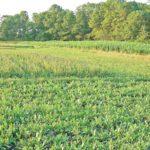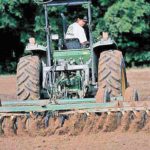
Even though a few game zones in South Carolina are already open for early-season velvet hunts, the remaining deer hunters in the Carolinas are anxiously awaiting Opening Day while plowing and planning out the last details of their fall food plots. Food plots play an important role in the overall management regime of raising and growing quality whitetail deer. Today’s hunters understand the benefits of warm-season and cool-season food plots and should be preparing to cover the fall seed mix this month. The annual budget for hunt clubs and wildlife managers should have seed, fertilizer, and tractor time scheduled each year. However, growing successful fall food plots requires careful planning, preparation, and protection.
The most important factor in establishing a thick, lush food plot, highly desired by deer and other wildlife, may not have anything to do the actual seed or seed mix planted. In fact, deer will eat almost any cultivated agriculture seed, as long as the crop is lush, tender and just tastes good.
While seed choice plays an important role, many hunters and wildlife managers spend too much time choosing that perfect seed or mix and not enough time preparing the ground, protecting the young crop, and keeping the plot growing.
“A successful food plot should last at least two to three months to receive the full benefits of the time and money invested,” said Terry Cooke of Longwood Hammocks Outfitters in Colleton County, S.C. (www.longwoodhammocksoutfitters.com) After 25 years of food-plot field trials and 10 years as a full-time farmer, he has learned the tricks of the trade to grow thick, lush food plots.
Prepare the Dirt
“Soil preparation is a key and the first, most-important aspect of preparing a potentially well-used food plot,” he said.
For starters, the soil must be aerated appropriately. Many managers fail to keep the planting area fully-aerated. Cooke recommends aerating the ground to 18 to 20 inches with a chisel plow at least once every four years. The healthy forage and seed heads observed above the ground get their looks from well-developed root systems. While leaf structure and photosynthesis are important, the complex root system gathers nutrients critical for strong growth. The roots on the young and developed plants must be unhindered. Overly-compacted soil is a killer and will quickly stunt a food plot.
After aerating, the soil should be individually tested at each site and the acidity adjusted within the specified pH range for each seed or mix with appropriate applications of lime. Testing and prescribing each plot individually will offer each seed or mix with the perfect conditions to be able to utilize supplemental nutrients added later as fertilizer.
Proper initial fertilization is also a critical component to growing a successful food plot and should be undertaken just before drilling or broadcasting seed. Take advantage of years of experimentation by the seed manufacturers and strictly follow their recommendations, printed on the back of the seed bag.
Protection is key
“The second most-important step to growing bountiful food plots is initial protection,” Cooke said. “Ironically, deer are a food plot’s worst enemy during the first month.”
Deer will home in on a newly-planted food plot just after the tender shoots break the soil surface and will quickly demolish the crop, destroying its season-long potential overnight. Although Cooke has tried several commercial deer-prevention solution systems, his custom “bag of tricks” tends to be the most effective, while also the least expensive and least cumbersome deterrent mechanism during the first month of growth.
Cooke gathers old white corn sacks and places a variety of deer repellents into them, including: dog dung, Irish Spring soap pieces, and a few handfuls of excess human hair he obtains from a local barbershop. He ties several of his “bags of tricks” on posts three to five feet off ground around the perimeter of the food plots. The sacks serve as a visual and smelly deterrent, preventing deer from using the food plot while installed.
Cooke sometimes ties pie plates on small tree branches along the edges of fields to scare deer away, or he will erect an old-fashioned scarecrow in blue jeans and red-checkered shirt with a bar of Irish Spring in one of the pockets. These homemade deterrents are inexpensive, but highly-effective for keeping deer off the plots during the critical first month of growth. When the deterrents are removed, deer will quickly move into the plots to feed aggressively. At this point, the plots will be well established and capable of heavy browsing.
Premium fall mixes and planting configurations
With cooler temperatures creeping in, fall plantings offering a balanced, energy-packed food source will quickly lure deer in to feast. Fall plantings should always contain a wide variety of seeds to offer the herd a choice and a season-long food source. Many manufacturers offer several complete fall mixes highly-desired by wildlife and loaded with nutrition.
“Cereal grains (oats, wheat, triticale, rye), annual clovers and other attractive annuals are very attractive and nutritious during the first 40 to 60 days of growth, but those statistics quickly drop right off the table,” said Todd Amenrud of Biologic, Scientifically Proven Wild Game Products.
Amenrud recommends planting a mixture of plants that mature and become palatable at different times, offering a choice for a longer period of time. Biologic’s Outfitters Blend was developed specifically to serve that purpose, combining oats, wheat, triticale, and Austrian Journey Pea in one mix. These blends, with variable maturation and palatability rates, prolong the effectiveness of the food plot through the hunting season.
Mixing seeds is on the top of Cooke’s successful food-plot tricks as well. He will plant 10 different seeds together in the same plot to prolong the effectiveness of the plot, but he also plants different seeds together to offer protection to young, vulnerable plants as well. He always includes rye and buckwheat with his clover plantings. The rye and buckwheat sprout quickly, shading and protecting the young clover from early damage. In addition, rye offers a quick forage for deer after sprouting and will not die after frosts, offering winter-long growth. Buckwheat is not palatable before it matures and will become the late-season hot spot after the majority of other seeds have played out.
Clovers are favored by wildlife and managers for their dense nutrition and resistance to heavy browsing. While Alyce clover and red clover are regulars and favored by Cooke, Imperial Whitetail Clover is his premium choice, with its rich protein content — 30 to 35 percent — outweighing the higher cost.
“Another approach to prolonging the effectiveness of food plots is to staggering plantings within the food plots themselves,” Amenrud said.
As long as plots are large enough — at least one or two acres — divide them into sections and plant each section several days to several weeks apart to extend the life of the overall plot.
Deer are innately-attracted to high-energy, palatable food crops, but keeping a constant flow of available nutrients can be cumbersome. However, careful planning, preparation, planting, and maintenance of food plots will improve the health of the herd and offer ample opportunity to fill several tags.






Be the first to comment